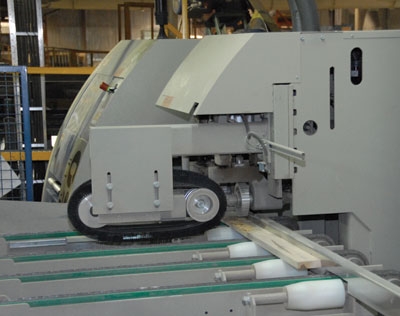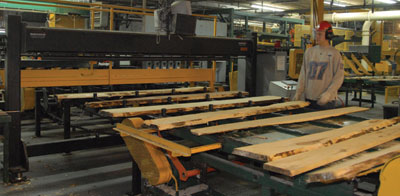
Features
Operation Reports
Remanufacturing
Value-Added Winner
When Alain Bossé was growing up in the small, predominantly French speaking western New Brunswick town of St. Quentin, one of his local teachers was Jean-Claude Savoie. Bossé didn’t know it at the time, but it’s probably a good thing he listened in class. Today, Monsieur Savoie, as he was known to his students, is the president of Groupe Savoie, a value-added wood products producer with manufacturing facilities across Atlantic Canada. And yes, you guessed it. Alain Bossé now works with him in the key role of vice-president and general manager.


December 2, 2011 By Bill Tice
 One of the plant’s two OptiCut 450 chopping lines. When Alain Bossé was growing up in the small
One of the plant’s two OptiCut 450 chopping lines. When Alain Bossé was growing up in the smallJean-Claude gave up teaching over 30 years ago to take up his other passion – the wood products business. It was 1978 and his father, Hector, was the general manager at Hardwood Industries, which was owned by Southampton Industries and was the local hardwood mill in St. Quentin. At the time, the only other mill in town, a softwood lumber and shingle mill, was up for sale. Hector and Jean-Claude decided they would buy it, but when Hector tendered his resignation at Southampton to start his new venture, the owner asked if the Savoies wanted to buy his mill as well. The answer was “yes” and Groupe Savoie was founded.
The Early Days
Early on, Lady Luck was not on the side of the Savoies and not long after they started the company a substantial amount of inventory was damaged by a fire. Then in 1980, another fire destroyed the hardwood mill. Following the fire in the hardwood mill, they converted the softwood mill to a hardwood facility as that is where Hector’s expertise was, but with a shutdown of over a year while they rebuilt and converted the facility, and interest rates hovering around 20%, they were facing extremely tough business conditions. They did manage to secure a loan and had the mill up and running again in 1980. They produced just 5 million board ft. in the first year by cutting and selling green hardwood lumber. They quickly realized that they had to do something else to stay afloat and by 1984, they were in the value-added business and producing pallet stock. That was the turning point for Group Savoie Bossé explains. “In the hardwood lumber business in our area, almost 90% of the trees harvested are pulpwood and only 10% are saw logs. They ended up with a huge volume of pulpwood and no market for it, so they decided to build a dedicated mill that could convert the pulpwood to 4-ft. material suitable for pallets and other value-added products. Today, that facility is our Savoie Sawmill and it produces 35 million board ft. of products annually.”
In the early 1990s, Groupe Savoie took another step forward, building a pallet assembly plant at its St. Quentin site that today has a capacity of 2 million pallets per year, including ISPM15 heat treated pallets for select markets. The pallet plant consumes a large portion of the production from the Savoie Sawmill; however, higher end wood from the sawmill is manufactured into hardwood flooring at the company’s component plant, which is also on the same site. “Our goal has always been to utilize 100% of the log and by producing pallets and other value-added products we are able to do that,” notes Bossé. “Jean-Claude has always said, ‘we must use everything the forest can give us,’ and that philosophy has
gone a long way in making this company successful.”
Today’s Company
Today, Groupe Savoie is the largest employer in St. Quentin. Their location, which is just on the outskirts of the town, is home to the Savoie Sawmill, the Restigouche sawmill, which was the original Groupe Savoie mill at this site, the pallet assembly plant, the component plant, and a new wood pellet production plant that will produce pellets for energy use once it starts up this summer. They also operate a second component plant in Kedgwick, which is just 20 km from St. Quentin, a second pallet plant in Moncton, N.B., and an additional sawmill in Westville, N.S. that predominantly sources logs from private woodlots and supplies a portion of the materials used at the company’s St. Quentin component and pallet plants. In addition, the company has its own woodlands group, which manages, sources and harvests over 430,000 cubic metres of timber annually from New Brunswick crown land, private woodlots and industrial leaseholds. In total, Groupe Savoie employs well over 500 people directly and has another 150 contractors who are almost entirely focused on working for
the company.
In addition to utilizing almost 100% of the logs, another reason for the success of Groupe Savoie is its ability to embrace and implement new technology into the production flow. A perfect example of this is the St. Quentin value-added component plant. With its combination of sleek machinery from various divisions of European equipment manufacturer Weinig, and conveyor systems from Mekanika Inc. of Sainte-Marie, Que., the plant gives the first time visitor an immediate sense of efficiency and high performance.
The St-Quentin component plant is fed by the Restigouche, Westville and Savoie sawmills and, if necessary, by direct purchase from industry partners. In total, it consumes more than 10 million board ft. of raw materials annually, all of which has been subjected to a highly precise and controlled drying process. This state-of-the-art plant produces a variety of components and glued panels made to client specifications. The main equipment in the component plant includes an OSI planer, LuxScan and CombiScan scanning gear from Weinig, a Raimann ripping line, and two OptiCut 450 chopping lines. A pair of Timesaver sanders are also located in the component plant and are used for sanding panels when required.

Although it is not as modern as the component plant, the Savoie sawmill is still highly automated and features Autolog and Inotech scanning at a number of production stations. Most logs coming into this mill are pulpwood that are 8 ft. in length. These logs are processed through a slasher deck where they are cut down to 4 ft. prior to going to a Fuji King debarker. The mill features two lines – the large line, which is a USNR twin line with a band saw, an edger and a trimmer, and a small line, which is a Comact canter line that has the capability to notch boards for pallet stock. Sorting and stacking is done with Gemofor equipment.
Much of the product from the Savoie sawmill is directed to the St. Quentin pallet manufacturing plant where the pallets are assembled, painted and heat-treated if necessary.
Other facilities at the St. Quentin site include the Restigouche sawmill, which features a VK Brunette debarker and a USNR twin band saw. Along with supplying product to the component and pallet plants, this mill produces railroad ties and other larger products. There are also eight 45,000-board-ft.-capacity Nardi dry kilns in St. Quentin, which are powered by 250-hp and 400-hp KMW boilers.
Down the road at Kedgwick, Groupe Savoie produces cabinet and furniture components, and hardwood flooring. Four M.E.C. dry kilns are located at this site. Farther away in Moncton, a second pallet plant helps Groupe Savoie reach its goal of maximizing resource use by recycling and reusing pallets and components from the St. Quentin facilities to manufacture new pallets and repair second-hand ones. The plant’s production capacity is 300,000 pallets per year.
Energy Products
The latest ventures for Groupe Savoie include the energy business and last year they installed two Ruff briquette machines at the St. Quentin site. They provide the company with the ability to produce 4,000 tonnes of briquettes on an annual basis, which are primarily consumed in the home heating business. Later this summer, the company’s brand new pellet plant will start up. The 8 to 10 tonne per hour pellet plant, which will feature an Andritz pellitizer, will take Groupe Savoie further into the biomass and energy business.
Commitment
Like most companies in the wood products business, the last couple of years have been extremely difficult for Groupe Savoie, but the company has still managed to maintain its employment levels in Atlantic Canada and it has continued to support the community through the Hector Savoie Foundation. Group Savoie also provides scholarship opportunities through the University of Moncton and an internal program that provides all children of Groupe Savoie employees with some financial assistance for post-secondary education.
Looking forward, Bossé envisions a strong future for the company. “We hope to never see the tough times of 2008 and 2009 again, but we are the type of guys that are very optimistic,” he says. “We believe that everything we have done in the past has positioned us well for the future. And we believe there is a future in this industry. If you have the fibre supply, the equipment, the people, the customers, and the determination and desire, you can do well, and I have no doubt in my mind that Groupe Savoie has all of the right components and will continue to succeed and grow.”
Print this page